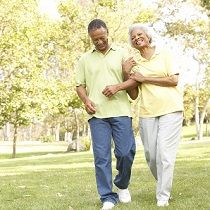Article
Despite Disease, Knee Osteoarthritis Patients Can Still Walk 6,000 Steps Per Day
Author(s):
A research team from the University of Delaware sought to see how much strength one would need, how fast they needed to walk, and how far they needed to walk to achieve a sufficient 6,000 steps in a day, and found that most knee OA patients surpassed their thresholds.

Osteoarthritis (OA) is believed to impact as many as 30 million Americans, rendering necessary daily exercise painfully difficult in nearly one in 10 people.
In light of this, Dr. Daniel White of the University of Delaware Department of Physical Therapy introduced a new study with his belief that it was “very important not only from a clinical perspective, but also from a public health perspective,” when he presented it at the 2016 American College of Rheumatology Annual Meeting in Washington, DC.
The team from Delaware sought to see measure how much physical capacity an individual with knee OA needed to have in order to maintain a healthy amount of physical activity, which for study purposes, they defined as walking a minimum of 6,000 steps per day. Specifically, they examined how much strength one would need, how fast they needed to walk, and how far they needed to walk to achieve that goal.
Using data from the Osteoarthritis Initiative, gathering a group of 1,790 participants who wore a research-grade monitor for three or more days (“Not a FitBit,” White jokes). The monitor objectively measured how many steps per day people walked, and they used objective measures for each of their points of interest.
Strength was measured by how long it took a patient to stand up from a chair five times. Speed was determined by how long it took for the participant to walk 20 meters, and endurance was determined by the time it took for them to walk 400 meters, roughly the loop of a high school track.
Among those in the cohort who were unable to walk 6,000 steps per day, they were able to find averages in their test performance that could indicate to clinicians which of their patients are unable to reach a healthy level of physical activity. Taking at least 12 seconds to complete the standing test, walking slower than 2.7 miles per hour, and taking more than five and a half minutes to walk 400 meters were all associated with an inability to achieve 6,000 steps per day.
“It’s important to note, and I find it very significant, that a majority of people with knee osteoarthritis actually meet these physical capacity thresholds,” White says, noting that when they compared their data with a previous study called the Multicenter Osteoarthritis Study, they found that 66% of knee OA patients met the strength thresholds, and 71% met both the speed and endurance thresholds.
He says these findings have clinical applicability, citing previous literature that showed that taking longer than 12 seconds in the standing-up test was actually predictive of falls in older adults.
“One of the most exciting things about the research is that this getting-up-from-a-chair test is something all physicians can do in their office…So taking the time to have them stand up from a chair five times, and if it takes them more than 12 seconds, they might need a referral to rehabilitation such as physical therapy.”
White believes that such ongoing research has the potential to help refine intervention strategies to more personally assist knee OA patients in maintaining healthy levels of physical activity.
Related Coverage:
“A Joint Operation”: Rheumatologists, Orthopedists Collaborate to Improve Patient Outcomes
Continuing Treatment in Postmenopausal Women with Osteoporosis
Anti-TNF Treatments for Ankylosing Spondylitis Decrease Need for Hip Replacement




